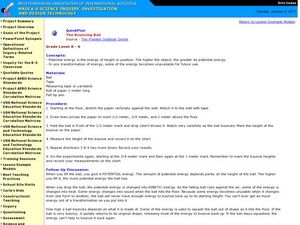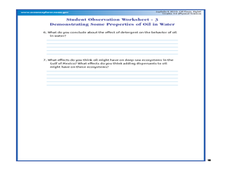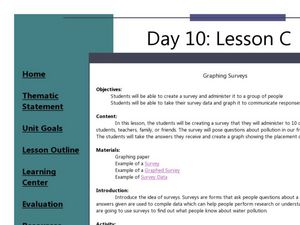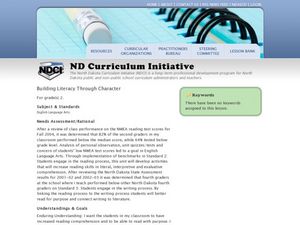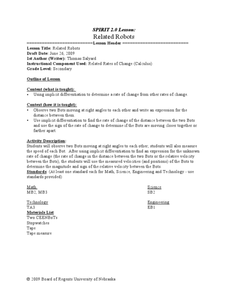Curated OER
The Bouncing Ball
Students use the scientific method to conduct an experiment to test how a ball bounces. In this inquiry-based physical science and scientific method lesson, students drop a ball from specified heights and record the rebound, then record...
Curated OER
A Demonstration of Photo-and Geotaxes in Nauplii of Artemia Salina
Students explore phototaxis and geotaxis in brine shrimp. In this phototaxis and geotaxis lesson plan, students study the effects of light and gravity on brine shrimp using a test tube, a pen light and gravity. They answer questions...
Curated OER
Air Pollution
Students collect and examine particulate matter found in the air. In this pollution activity, students use microscope slides and petroleum jelly to collect particulate matter from several different locations, then use a microscope to...
Curated OER
Popcorn Is a Gas
Students investigate why and how popcorn pops. In this gas lesson plan, students observe and make suggestions as to what causes popcorn to pop after observing popped corn and corn kernels. Students mass the kernels before and after...
Curated OER
Air Pressure
Students perform experiments that demonstrate the characteristics of air pressure. In this physics lesson, students participate and observe experiments using simple household items. The results of these experiments are used to help the...
Stanford University
Mexicans in the United States in the 1920s
Students explore what life was like for Mexicans and Mexican-Americans in the 1920s. In this American history lesson, students watch videos and refer to multiple documents to draw conclusions as to what life was like for Mexican workers...
Curated OER
Why is The Sky Blue?
Students explore why the sky is blue. In this light lesson, students conduct an experiment using water, flashlights, and milk to test why the sky is blue. Students view a PowerPoint, take notes on their results and draw conclusions.
Curated OER
Oil Floats, Right?
Students examine the properties in oil in water. In this mixture lesson, students read about the Lophelia II 2010: Cold Seeps and Deep Reef Expedition and look at images of deep sea ecosystems. They experiment or participate in...
Curated OER
Chain Letters and Pyramid Schemes
In this statistics lesson, students analyze chain letters and draw conclusions of the outrageous amount of letters that would be mailed out if people really followed through. This is more of a thought provoking worksheet than problem...
Curated OER
Pasta Bridges
Students analyze the correct use of technology as it relates to math and science. In this science instructional activity, students investigate force and weight as it relates to building an object. They build a bridge and draw conclusion...
Curated OER
Properties of Fresh Water and Sea Water
Students conduct experiments using water. In this properties of fresh and sea water instructional activity, students investigate boiling point, freezing point, and the water's retention of heat. Students hypothesize, collect and record...
Curated OER
Graphing Surveys
Students collect data and graph it. In this algebra lesson, students create a survey for their classmates and teachers. They analyze the results from the survey and graph it. They draw conclusion from their data based on the graph.
Curated OER
Harry Potter Research Project
Young scholars work together to complete a research project on Harry Potter. They write a research question and develop a survey to give to their classmates. Using the results, they create a graph and draw conclusions about the data...
Curated OER
Guess What?!
Students explore how scientists work. In this scientific method activity, students use their senses to identify objects they cannot see. Students are asked to think like scientists and make observations, comparisons, and interferences,...
Curated OER
The African Burial Ground
Students analyze African American burial grounds. In this African American history lesson, students draw conclusions about African American communities in early New York and consider how archeology made it possible to study the communities.
Curated OER
The Day the Atom Died (Grade K-1)
Students investigate what is wrong with the Rutherford atomic model. In this chemistry instructional activity, students answer questions about the atomic model after watching a video. They draw conclusions from the video and discuss how...
Curated OER
Springy Legs
Fifth graders measure their body height and the height they can jump. They use these measurements in forms of ratios, fractions and decimals to describe their Springy Legs Factors (SLF). Students compare their SLFs to other people's...
Curated OER
The Roanoke Mystery
Fourth graders hypothesize about what happened on the island of Roanoke. In this South Carolina history instructional activity, 4th graders use primary documents to draw conclusions about what happened to the Lost Colony of Roanoke. This...
Curated OER
Parliamentary Newsroom : Developing Media Literacy
Students explain and examine the selection, development, sources, transmission and impact of news on the public. They write a brief essay on the topic: "The Public Must Be Critical In Their Assessment of the News Before Drawing...
Curated OER
Voting Then and Now
Students consider the impact of the Voting Rights Act as they examine voting practices today. In this voting lesson, students research details regarding the Voting Rights Act and then read a handout regarding voting data from the early...
Curated OER
Oil and Energy Consumption
Young scholars analyze the oil consumption and production information. In this investigative lesson students take the data collected, graph and organize it then draw conclusions about the use of oil worldwide.
Curated OER
Building Literacy Through Character
Second graders connect reading to writing by making predictions, completing text to world connections, solving problems, and more. In this reading and writing lesson plan, 2nd graders draw conclusions after reading and write them down.
Curated OER
Related Robots
Students solve problems using implicit differentiation. In this calculus lesson, students take the derivative to calculate the rate of change. They observe two robots and draw conclusion from the data collected on the two robots.
Curated OER
Cloudy vs. Clear
Students analyze line plots. In this weather lesson using real NASA data, students discuss how weather affects the way the Earth is heated by comparing different line plots.


